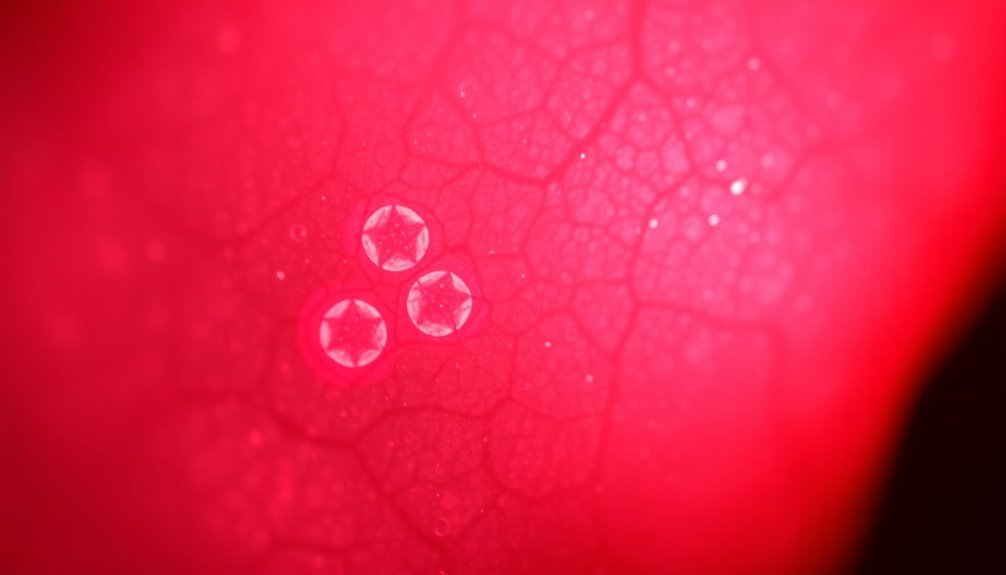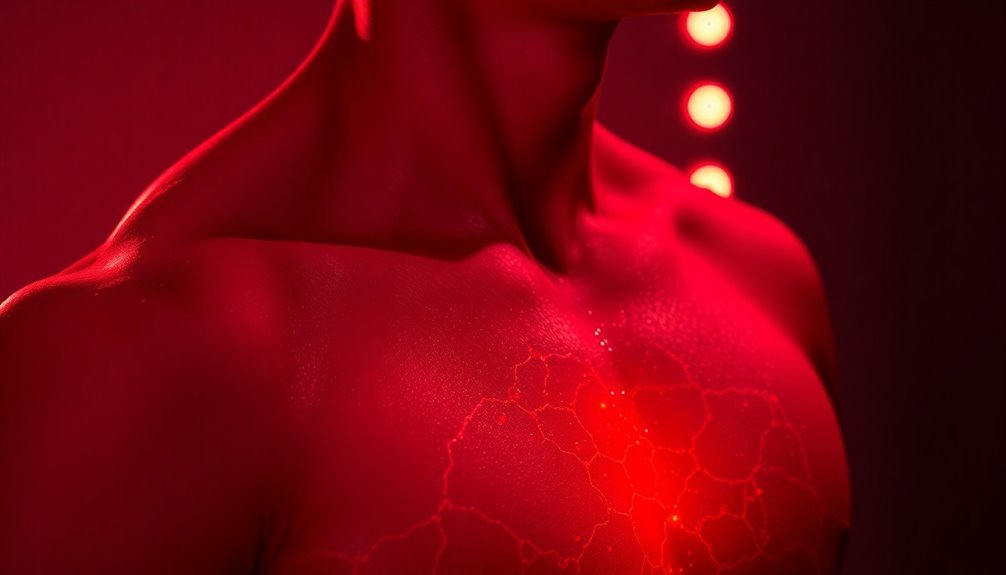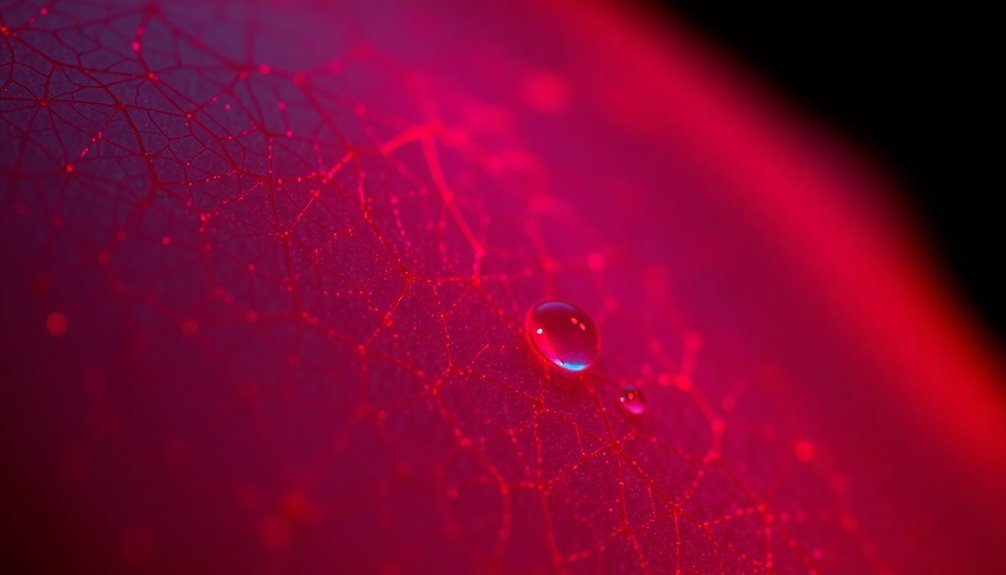Red light therapy can supercharge your mitochondrial performance through five key benefits. You'll experience enhanced ATP production as specific wavelengths (630-850 nm) activate your cellular energy systems. Your cells will work more efficiently, with improved energy usage and reduced oxidative stress. The therapy strengthens mitochondrial function by optimizing cytochrome c oxidase activity, while simultaneously decreasing harmful free radicals in your system. Your electron transport chain will operate at peak efficiency, boosting overall cellular endurance. These powerful effects can transform your cellular health, and there's much more to discover about this revolutionary treatment.
ATP Production Boost

Operating at the cellular level, red and near-infrared light therapy revolutionizes how your mitochondria produce energy. When you expose your cells to specific wavelengths between 630-850 nm, you're activating a powerful mechanism that enhances your body's natural ATP production process.
This targeted light therapy directly stimulates your mitochondria's electron transport system and increases cytochrome c oxidase activity, leading to improved cellular energy output.
You'll notice the benefits through enhanced muscle endurance and faster recovery times. The therapy's impact on your cellular respiration means your cells can produce more energy for intensive activities, whether you're an athlete or someone dealing with fatigue-related issues.
Your mitochondria respond to this treatment by ramping up their energy-producing capabilities, creating more ATP to fuel your body's needs. The blood flow stimulation helps deliver essential nutrients and oxygen to your muscle tissues.
The science behind this process is well-documented through both preclinical and human studies. Research consistently shows that when you use red light therapy, you're not just temporarily boosting energy – you're optimizing your cells' power plants for improved performance.
This enhanced ATP production translates to real-world benefits, supporting everything from athletic performance to overall cellular health.
Cellular Energy Efficiency
Optimized cellular function stands at the core of red light therapy's remarkable impact on energy efficiency. When you expose your cells to red light, they become more efficient at handling increased ATP demands while reducing oxidative stress. This enhanced efficiency directly translates to improved cellular respiration and better overall energy utilization at the microscopic level. The therapeutic wavelengths between 630 and 850 nanometers provide optimal benefits without any adverse effects.
Your cells' mitochondrial complex respiration gets a significant boost, particularly in the electron transport system capacity and cytochrome c oxidase activity. The near-infrared wavelengths penetrate deep into your tissues, reaching muscles, bones, and organs to support cellular energy processes.
Here's how red light therapy optimizes your cellular energy efficiency:
- Strengthens your cells' resistance to external stressors like KCl-induced stress
- Increases cell viability and metabolism through continuous light exposure
- Enhances mitochondrial pathways for improved energy production
- Reduces inflammatory processes while supporting ATP generation
The result is a more streamlined cellular energy system that operates at peak efficiency. Your cells become better at producing and utilizing energy, leading to improved tissue restoration, faster healing, and enhanced overall cellular performance.
Mitochondrial Function Enhancement

Red light therapy's profound influence on mitochondrial function stems from its unique ability to target and enhance cellular powerhouses. When red-to-NIR light penetrates your skin, it reaches depths of 0.5mm to 50mm, directly impacting your mitochondria without causing heat or UV damage.
The therapy works by separating nitric oxide from cytochrome c oxidase, which boosts your cellular respiration and ATP production. You'll find the most effective results within the 630-850nm wavelength range, where the light specifically enhances your electron transport system's capacity. Low-level laser therapy shows consistently positive results for healing and repair at the cellular level.
Both continuous and pulsed light at 850nm and 940nm wavelengths strengthen your cells' resistance to external stress.
You'll experience improved cellular energy levels as your mitochondria become more efficient at producing ATP. This enhancement doesn't just affect one system – it benefits your entire body, from neuronal metabolism to skin health.
If you're dealing with neurodegenerative conditions, chronic pain, or even hair loss, you'll find that regular red light therapy sessions can help. The treatment's safety profile is strong when used correctly, though you'll need to maintain consistent use for sustained benefits.
Oxidative Stress Reduction
A cascade of beneficial effects occurs when red light therapy targets oxidative stress in your cells. When specific wavelengths of red and near-infrared light penetrate your tissues, they trigger mechanisms that help balance reactive oxygen species (ROS) and enhance your body's natural antioxidant defenses.
Your cells respond to red light therapy through multiple pathways that reduce oxidative damage:
- Mitochondria absorb the red light and increase ATP production, leading to improved cellular energy and reduced oxidative stress.
- The therapy activates key enzymes like catalase and formaldehyde dehydrogenase, which help neutralize harmful free radicals.
- Brief, controlled bursts of ROS during treatment actually stimulate beneficial cellular adaptations and healing responses.
- Your cells produce new mitochondria, enhancing their ability to manage oxidative stress long-term.
Modern environmental factors like UV radiation and pollution can accelerate oxidative damage, making protective interventions crucial.
You'll find the most effective results using medical-grade devices at appropriate intensities and durations. Research shows that 630nm wavelengths are particularly effective at reducing brain oxidative stress markers and improving memory function.
When you combine red light therapy with a healthy lifestyle, you're supporting your cellular health through multiple complementary pathways.
Electron Transport Chain Optimization

Through precise wavelengths of light therapy, your mitochondria's electron transport chain undergoes significant enhancement, leading to more efficient cellular energy production.
Red light therapy specifically targets mitochondrial complexes I, III, and IV, optimizing the electron transport system's capacity to generate ATP, your cells' primary energy source.
When you expose your body to red and near-infrared light in the 630-850nm range, you'll activate cytochrome c oxidase, an essential enzyme in the electron transport chain. These wavelengths are particularly effective since visible and IR radiation comprise 95% of solar radiation reaching Earth's surface.
This activation improves your cells' ability to handle higher ATP demands and enhances their resilience under stress. The 850nm wavelength proves particularly effective in stimulating mitochondrial respiration and promoting deep tissue penetration.
You'll achieve the best results through consistent application, as the benefits are dose-dependent.
Both continuous and pulsed light therapy protocols can optimize your electron transport chain function, but you'll need regular sessions to maintain these improvements.
This enhanced mitochondrial function translates into better cellular energy metabolism, supporting prolonged physical activities and improving your overall endurance levels.
Frequently Asked Questions
How Long Does It Take to See Mitochondrial Performance Improvements From Red Light Therapy?
You'll notice immediate energy boosts after one session, but for significant mitochondrial improvements, you'll need 2-4 weeks of consistent daily treatment. Best results come from maintaining regular sessions over several months.
Can Red Light Therapy Damage Mitochondria if Used Too Frequently?
While there's no direct evidence of mitochondrial damage from red light therapy, you shouldn't overuse it. Using it too frequently may reduce its effectiveness and could potentially cause cellular stress. Follow recommended treatment protocols.
What's the Ideal Time of Day for Red Light Therapy Sessions?
You'll get ideal benefits from red light therapy in the morning to boost energy and regulate your circadian rhythm. However, you can still achieve great results any time of day with consistent sessions.
Does Red Light Therapy Work Differently for Athletes Versus Sedentary Individuals?
Yes, it'll work differently for you depending on your activity level. Athletes need more intense, frequent sessions for muscle recovery, while sedentary individuals benefit from gentler sessions focusing on general wellness and energy production.
Are There Any Supplements That Enhance Red Light Therapy's Mitochondrial Benefits?
Yes, you'll enhance red light therapy's mitochondrial benefits by taking CoQ10, vitamin D, NAC, and PQQ. These supplements boost energy production, support mitochondrial biogenesis, and improve the therapy's overall effectiveness.
In Summary
You'll see significant improvements in your cellular health when you harness red light therapy's power for mitochondrial function. From boosting ATP production to reducing oxidative stress, you're giving your cells the tools they need to perform effectively. By enhancing your electron transport chain and improving overall mitochondrial efficiency, you're setting yourself up for better energy levels and improved cellular performance at the most fundamental level.





Leave a Reply